Sustainable Tourism Development: Planning and Impact Analysis
VerifiedAdded on 2020/02/05
|20
|5689
|33
Report
AI Summary
This report examines sustainable tourism development, focusing on the Philippines. It explores the rationale for planning, the benefits of public-private partnerships, and various approaches to tourism planning. The report analyzes features of tourism development planning, including economic, environmental, and social impacts. It evaluates the significance of interactive planning systems and methods for measuring tourist impact. Furthermore, the report justifies the need for sustainability, analyzes factors hindering sustainable tourism, and discusses planning stages. Current issues like conflict resolution, supply-demand balancing, and enclave tourism ethics are evaluated. Finally, the report compares tourism impacts in developing and emerging destinations and provides recommendations for future development, emphasizing socio-cultural, environmental, and economic considerations.
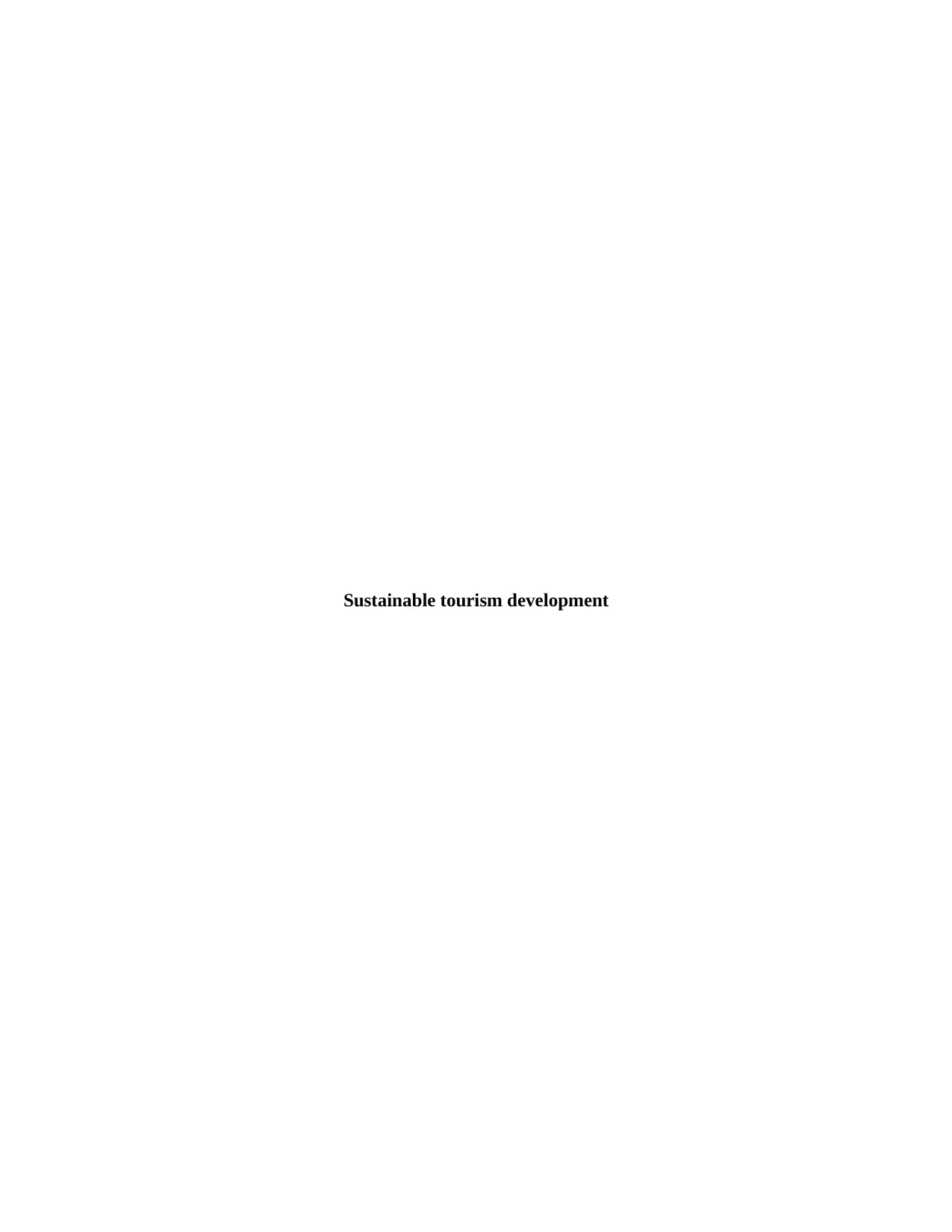
Sustainable tourism development
Paraphrase This Document
Need a fresh take? Get an instant paraphrase of this document with our AI Paraphraser

Table of contents
Introduction......................................................................................................................................4
Task 1...............................................................................................................................................5
1. Understanding the rationale for planning in the travel and tourism industry..............................5
1.1. Discussing the benefit of planning the tourism development...................................................5
1.2. Discussing the advantages and the disadvantages of the public or private sector tourism
planning partnerships.......................................................................................................................6
Task 2...............................................................................................................................................7
2. Understanding the different approaches to tourism planning and development.........................7
2.1. Analyzing features of tourism development planning..............................................................7
2.2. Evaluating the significance of interactive planning systems and processes in tourism
development.....................................................................................................................................8
2.3 Evaluate different methods available to measure tourist impact...............................................9
Task 3.............................................................................................................................................11
3. Understanding the need for planning for sustainable tourism...................................................11
3.1 Justifying the introduction of the concept of sustainability in tourism development..............11
3.2 Analyzing the factors that may prevent/hinder sustainable tourism development..................11
3.3 Analyzing the different stages in planning for sustainability..................................................11
Task 4.............................................................................................................................................14
4. Understanding the current issues related to tourism development planning.............................14
4.1 Evaluate methods of resolving a conflict of interests to ensure the future wellbeing of a
developing tourism destination......................................................................................................14
4.2 Analyzing the implications of balancing supply and demand.................................................15
4.3 Evaluating the moral and ethical issues of enclave tourism....................................................15
Task 5.............................................................................................................................................16
5. Understanding the socio-cultural, environmental and economic impacts of tourism in
developing countries and emerging destinations...........................................................................16
5.1. Compare current issues associated with tourism development in a developing country and an
emerging destination where the impacts of tourism are different.................................................16
5.2. Evaluating, with recommendations, the future development of tourism................................17
Conclusion.....................................................................................................................................18
Introduction......................................................................................................................................4
Task 1...............................................................................................................................................5
1. Understanding the rationale for planning in the travel and tourism industry..............................5
1.1. Discussing the benefit of planning the tourism development...................................................5
1.2. Discussing the advantages and the disadvantages of the public or private sector tourism
planning partnerships.......................................................................................................................6
Task 2...............................................................................................................................................7
2. Understanding the different approaches to tourism planning and development.........................7
2.1. Analyzing features of tourism development planning..............................................................7
2.2. Evaluating the significance of interactive planning systems and processes in tourism
development.....................................................................................................................................8
2.3 Evaluate different methods available to measure tourist impact...............................................9
Task 3.............................................................................................................................................11
3. Understanding the need for planning for sustainable tourism...................................................11
3.1 Justifying the introduction of the concept of sustainability in tourism development..............11
3.2 Analyzing the factors that may prevent/hinder sustainable tourism development..................11
3.3 Analyzing the different stages in planning for sustainability..................................................11
Task 4.............................................................................................................................................14
4. Understanding the current issues related to tourism development planning.............................14
4.1 Evaluate methods of resolving a conflict of interests to ensure the future wellbeing of a
developing tourism destination......................................................................................................14
4.2 Analyzing the implications of balancing supply and demand.................................................15
4.3 Evaluating the moral and ethical issues of enclave tourism....................................................15
Task 5.............................................................................................................................................16
5. Understanding the socio-cultural, environmental and economic impacts of tourism in
developing countries and emerging destinations...........................................................................16
5.1. Compare current issues associated with tourism development in a developing country and an
emerging destination where the impacts of tourism are different.................................................16
5.2. Evaluating, with recommendations, the future development of tourism................................17
Conclusion.....................................................................................................................................18

Reference list.................................................................................................................................19
⊘ This is a preview!⊘
Do you want full access?
Subscribe today to unlock all pages.

Trusted by 1+ million students worldwide
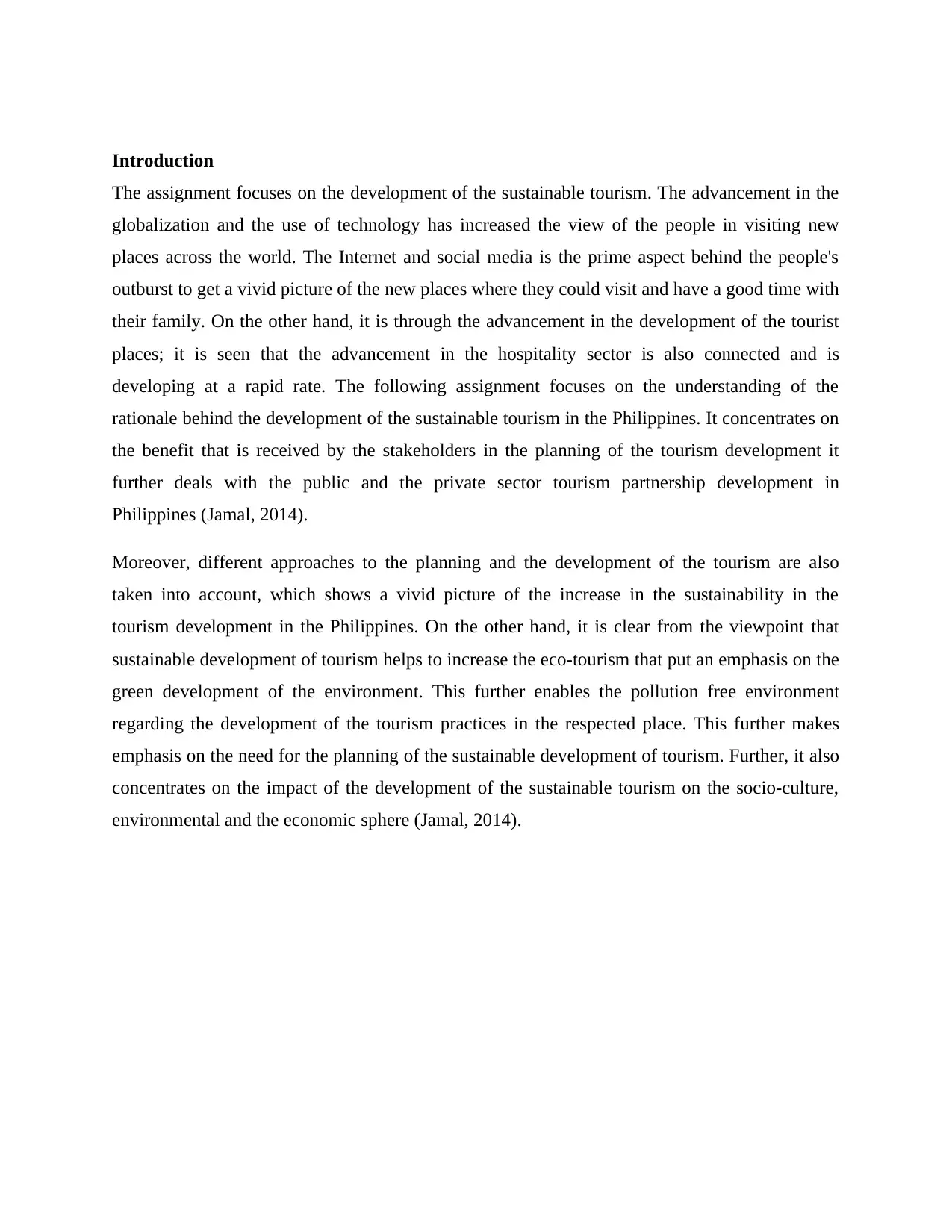
Introduction
The assignment focuses on the development of the sustainable tourism. The advancement in the
globalization and the use of technology has increased the view of the people in visiting new
places across the world. The Internet and social media is the prime aspect behind the people's
outburst to get a vivid picture of the new places where they could visit and have a good time with
their family. On the other hand, it is through the advancement in the development of the tourist
places; it is seen that the advancement in the hospitality sector is also connected and is
developing at a rapid rate. The following assignment focuses on the understanding of the
rationale behind the development of the sustainable tourism in the Philippines. It concentrates on
the benefit that is received by the stakeholders in the planning of the tourism development it
further deals with the public and the private sector tourism partnership development in
Philippines (Jamal, 2014).
Moreover, different approaches to the planning and the development of the tourism are also
taken into account, which shows a vivid picture of the increase in the sustainability in the
tourism development in the Philippines. On the other hand, it is clear from the viewpoint that
sustainable development of tourism helps to increase the eco-tourism that put an emphasis on the
green development of the environment. This further enables the pollution free environment
regarding the development of the tourism practices in the respected place. This further makes
emphasis on the need for the planning of the sustainable development of tourism. Further, it also
concentrates on the impact of the development of the sustainable tourism on the socio-culture,
environmental and the economic sphere (Jamal, 2014).
The assignment focuses on the development of the sustainable tourism. The advancement in the
globalization and the use of technology has increased the view of the people in visiting new
places across the world. The Internet and social media is the prime aspect behind the people's
outburst to get a vivid picture of the new places where they could visit and have a good time with
their family. On the other hand, it is through the advancement in the development of the tourist
places; it is seen that the advancement in the hospitality sector is also connected and is
developing at a rapid rate. The following assignment focuses on the understanding of the
rationale behind the development of the sustainable tourism in the Philippines. It concentrates on
the benefit that is received by the stakeholders in the planning of the tourism development it
further deals with the public and the private sector tourism partnership development in
Philippines (Jamal, 2014).
Moreover, different approaches to the planning and the development of the tourism are also
taken into account, which shows a vivid picture of the increase in the sustainability in the
tourism development in the Philippines. On the other hand, it is clear from the viewpoint that
sustainable development of tourism helps to increase the eco-tourism that put an emphasis on the
green development of the environment. This further enables the pollution free environment
regarding the development of the tourism practices in the respected place. This further makes
emphasis on the need for the planning of the sustainable development of tourism. Further, it also
concentrates on the impact of the development of the sustainable tourism on the socio-culture,
environmental and the economic sphere (Jamal, 2014).
Paraphrase This Document
Need a fresh take? Get an instant paraphrase of this document with our AI Paraphraser
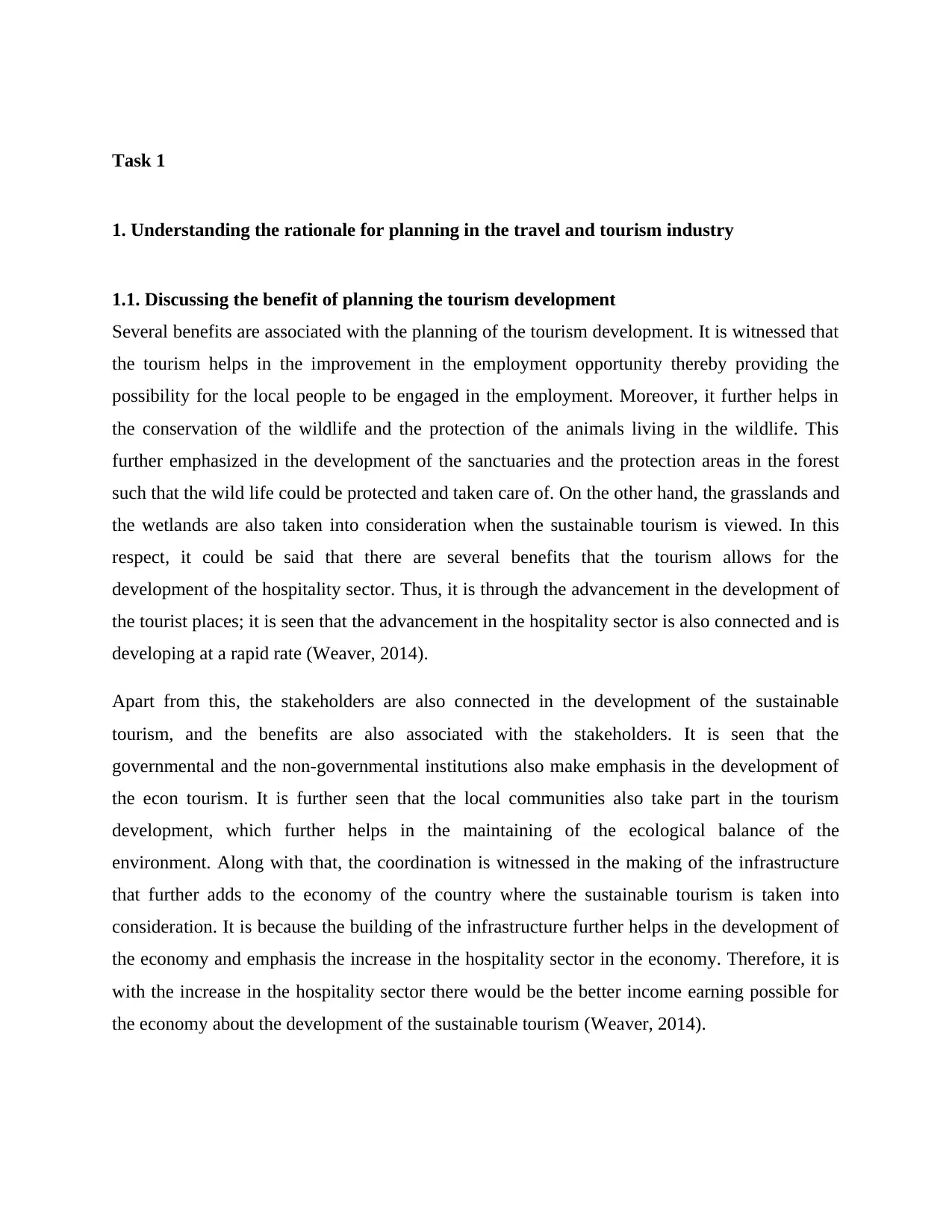
Task 1
1. Understanding the rationale for planning in the travel and tourism industry
1.1. Discussing the benefit of planning the tourism development
Several benefits are associated with the planning of the tourism development. It is witnessed that
the tourism helps in the improvement in the employment opportunity thereby providing the
possibility for the local people to be engaged in the employment. Moreover, it further helps in
the conservation of the wildlife and the protection of the animals living in the wildlife. This
further emphasized in the development of the sanctuaries and the protection areas in the forest
such that the wild life could be protected and taken care of. On the other hand, the grasslands and
the wetlands are also taken into consideration when the sustainable tourism is viewed. In this
respect, it could be said that there are several benefits that the tourism allows for the
development of the hospitality sector. Thus, it is through the advancement in the development of
the tourist places; it is seen that the advancement in the hospitality sector is also connected and is
developing at a rapid rate (Weaver, 2014).
Apart from this, the stakeholders are also connected in the development of the sustainable
tourism, and the benefits are also associated with the stakeholders. It is seen that the
governmental and the non-governmental institutions also make emphasis in the development of
the econ tourism. It is further seen that the local communities also take part in the tourism
development, which further helps in the maintaining of the ecological balance of the
environment. Along with that, the coordination is witnessed in the making of the infrastructure
that further adds to the economy of the country where the sustainable tourism is taken into
consideration. It is because the building of the infrastructure further helps in the development of
the economy and emphasis the increase in the hospitality sector in the economy. Therefore, it is
with the increase in the hospitality sector there would be the better income earning possible for
the economy about the development of the sustainable tourism (Weaver, 2014).
1. Understanding the rationale for planning in the travel and tourism industry
1.1. Discussing the benefit of planning the tourism development
Several benefits are associated with the planning of the tourism development. It is witnessed that
the tourism helps in the improvement in the employment opportunity thereby providing the
possibility for the local people to be engaged in the employment. Moreover, it further helps in
the conservation of the wildlife and the protection of the animals living in the wildlife. This
further emphasized in the development of the sanctuaries and the protection areas in the forest
such that the wild life could be protected and taken care of. On the other hand, the grasslands and
the wetlands are also taken into consideration when the sustainable tourism is viewed. In this
respect, it could be said that there are several benefits that the tourism allows for the
development of the hospitality sector. Thus, it is through the advancement in the development of
the tourist places; it is seen that the advancement in the hospitality sector is also connected and is
developing at a rapid rate (Weaver, 2014).
Apart from this, the stakeholders are also connected in the development of the sustainable
tourism, and the benefits are also associated with the stakeholders. It is seen that the
governmental and the non-governmental institutions also make emphasis in the development of
the econ tourism. It is further seen that the local communities also take part in the tourism
development, which further helps in the maintaining of the ecological balance of the
environment. Along with that, the coordination is witnessed in the making of the infrastructure
that further adds to the economy of the country where the sustainable tourism is taken into
consideration. It is because the building of the infrastructure further helps in the development of
the economy and emphasis the increase in the hospitality sector in the economy. Therefore, it is
with the increase in the hospitality sector there would be the better income earning possible for
the economy about the development of the sustainable tourism (Weaver, 2014).

1.2. Discussing the advantages and the disadvantages of the public or private sector
tourism planning partnerships
Public and private partnerships (PPP) are mostly encouraged by the Government. As mentioned
earlier the stakeholders in the company are government, which will come under public sector, the
tourism industry that will come under private sector, and there are local communities and the
tourists. The partnership is usually supported, as it is believed that due to the partnership the
tourist destination could gain some competitive advantage due to the knowledge and expertise
from various stakeholders (Weaver, 2014).
The various advantages of a public and private partnership are the distribution of power among
all the partners equally, which avoids any dictatorship. All the stakeholders involved either
public or private will have a direct impact on any issue, or hence they all will work more
effectively solve any particular issue. This will bring more cooperation and collaboration among
the members. Also, the members will work with more commitment level. Involvement of more
parties will bring in more knowledge and or expertise within the industry.
Usually, the public and the private collaborations are done to develop the area and attract more
and more tourists. The collaborations are advantageous in the sense that they bring a lot of
development and improvement in the region.
On the other hand, there are some disadvantages too of such partnership. The first and most
common disadvantage is that the partners have already a perception about each other, which
hinder the work largely. Also, since all involved parties have different objectives and goals, so
the clash of interests takes place. Moreover, sometimes the accountability and responsibilities are
not clear for different parties (Cohen, 2014).
For example, the government loses its control i.e. since the private partners have invested a lot in
the event and they will claim their involvement in taking important decisions too. There could be
a clash of responsibilities. Since everyone will be working in collaboration, there will make no
sense of competition, and it is a known fact that competition leads to novelty and greater
proficiency (Weaver, 2014).
tourism planning partnerships
Public and private partnerships (PPP) are mostly encouraged by the Government. As mentioned
earlier the stakeholders in the company are government, which will come under public sector, the
tourism industry that will come under private sector, and there are local communities and the
tourists. The partnership is usually supported, as it is believed that due to the partnership the
tourist destination could gain some competitive advantage due to the knowledge and expertise
from various stakeholders (Weaver, 2014).
The various advantages of a public and private partnership are the distribution of power among
all the partners equally, which avoids any dictatorship. All the stakeholders involved either
public or private will have a direct impact on any issue, or hence they all will work more
effectively solve any particular issue. This will bring more cooperation and collaboration among
the members. Also, the members will work with more commitment level. Involvement of more
parties will bring in more knowledge and or expertise within the industry.
Usually, the public and the private collaborations are done to develop the area and attract more
and more tourists. The collaborations are advantageous in the sense that they bring a lot of
development and improvement in the region.
On the other hand, there are some disadvantages too of such partnership. The first and most
common disadvantage is that the partners have already a perception about each other, which
hinder the work largely. Also, since all involved parties have different objectives and goals, so
the clash of interests takes place. Moreover, sometimes the accountability and responsibilities are
not clear for different parties (Cohen, 2014).
For example, the government loses its control i.e. since the private partners have invested a lot in
the event and they will claim their involvement in taking important decisions too. There could be
a clash of responsibilities. Since everyone will be working in collaboration, there will make no
sense of competition, and it is a known fact that competition leads to novelty and greater
proficiency (Weaver, 2014).
⊘ This is a preview!⊘
Do you want full access?
Subscribe today to unlock all pages.

Trusted by 1+ million students worldwide
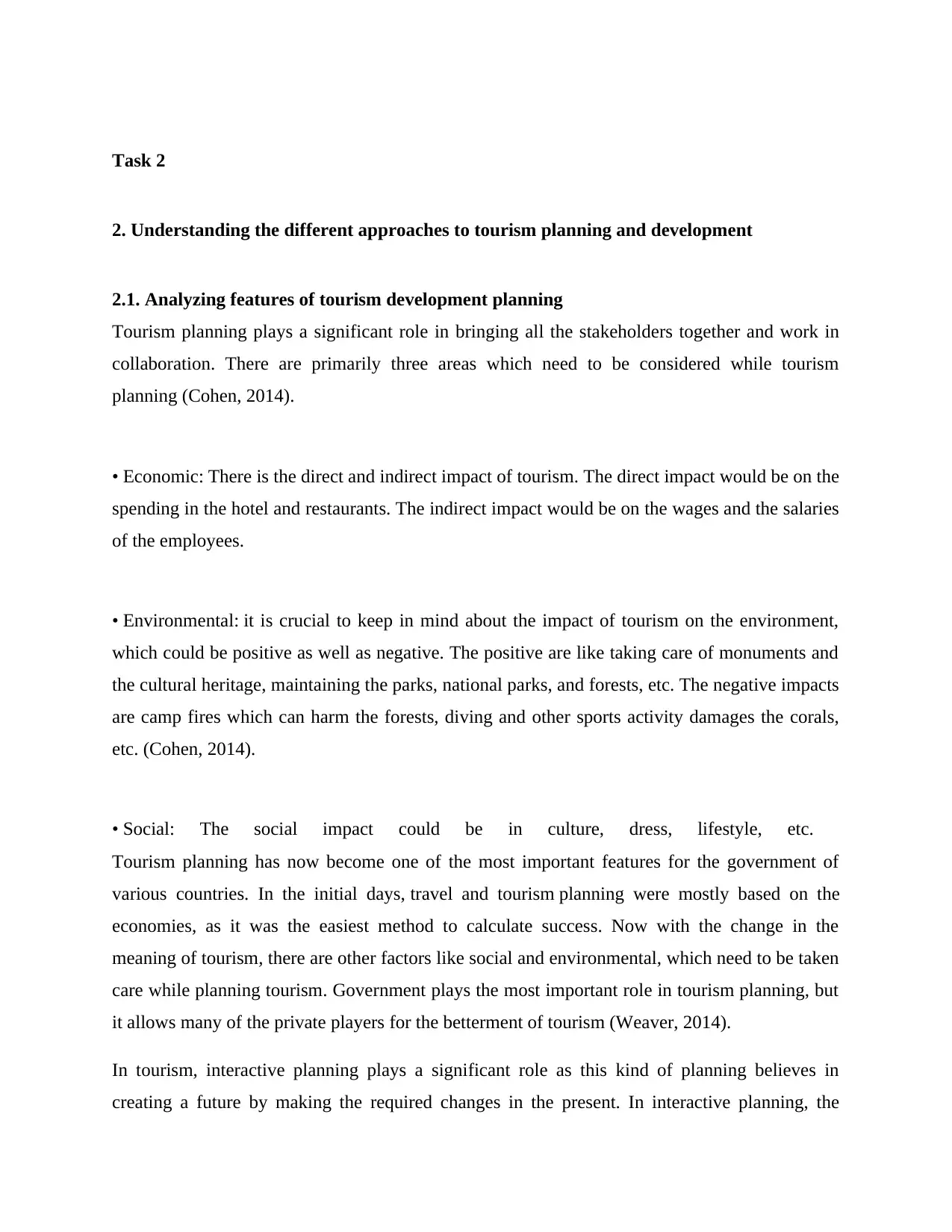
Task 2
2. Understanding the different approaches to tourism planning and development
2.1. Analyzing features of tourism development planning
Tourism planning plays a significant role in bringing all the stakeholders together and work in
collaboration. There are primarily three areas which need to be considered while tourism
planning (Cohen, 2014).
• Economic: There is the direct and indirect impact of tourism. The direct impact would be on the
spending in the hotel and restaurants. The indirect impact would be on the wages and the salaries
of the employees.
• Environmental: it is crucial to keep in mind about the impact of tourism on the environment,
which could be positive as well as negative. The positive are like taking care of monuments and
the cultural heritage, maintaining the parks, national parks, and forests, etc. The negative impacts
are camp fires which can harm the forests, diving and other sports activity damages the corals,
etc. (Cohen, 2014).
• Social: The social impact could be in culture, dress, lifestyle, etc.
Tourism planning has now become one of the most important features for the government of
various countries. In the initial days, travel and tourism planning were mostly based on the
economies, as it was the easiest method to calculate success. Now with the change in the
meaning of tourism, there are other factors like social and environmental, which need to be taken
care while planning tourism. Government plays the most important role in tourism planning, but
it allows many of the private players for the betterment of tourism (Weaver, 2014).
In tourism, interactive planning plays a significant role as this kind of planning believes in
creating a future by making the required changes in the present. In interactive planning, the
2. Understanding the different approaches to tourism planning and development
2.1. Analyzing features of tourism development planning
Tourism planning plays a significant role in bringing all the stakeholders together and work in
collaboration. There are primarily three areas which need to be considered while tourism
planning (Cohen, 2014).
• Economic: There is the direct and indirect impact of tourism. The direct impact would be on the
spending in the hotel and restaurants. The indirect impact would be on the wages and the salaries
of the employees.
• Environmental: it is crucial to keep in mind about the impact of tourism on the environment,
which could be positive as well as negative. The positive are like taking care of monuments and
the cultural heritage, maintaining the parks, national parks, and forests, etc. The negative impacts
are camp fires which can harm the forests, diving and other sports activity damages the corals,
etc. (Cohen, 2014).
• Social: The social impact could be in culture, dress, lifestyle, etc.
Tourism planning has now become one of the most important features for the government of
various countries. In the initial days, travel and tourism planning were mostly based on the
economies, as it was the easiest method to calculate success. Now with the change in the
meaning of tourism, there are other factors like social and environmental, which need to be taken
care while planning tourism. Government plays the most important role in tourism planning, but
it allows many of the private players for the betterment of tourism (Weaver, 2014).
In tourism, interactive planning plays a significant role as this kind of planning believes in
creating a future by making the required changes in the present. In interactive planning, the
Paraphrase This Document
Need a fresh take? Get an instant paraphrase of this document with our AI Paraphraser

planners, believe in the fact that their future will depend on all the actions that they will take
between today and the future. As mentioned earlier, during the game events the entire step needs
to be taken between today and the event date to create a nice tourism spot. Hence, interactive
planning is best for tourism planning. It is also believed that a lot of serious impact on
environment and economy could be avoided with the help of interactive planning (Cohen, 2014).
2.2. Evaluating the significance of interactive planning systems and processes in tourism
development
The above discussion clearly highlights the benefit of having sustainable cultural tourism.
However, there are certain factors that impact the sustainable cultural tourism. Firstly the cultural
tourism cannot be used to create instant demand. For example events such as sporting events or
ceremonies may create instant tourism demand. Such aspects are missing in cultural tourism.
Although this can be aggravated by highlighting the cultural practices backed by seasons, this
would require huge efforts regarding marketing. In a case of sporting events the marketing is
done at different levels, by different countries and the intended public is targeted by various
agencies (Cohen, 2014).
Another important aspect is that the cultural sites and building may be impacted by the tourists.
For example, the historical places might lose its identity due to continuous degradation due to its
exposure to the large population. This will increase the cost of maintenance for safeguarding the
heritage sites. This is a continuous process. Such costs are not involved in organizing sporting
events or other such tourism (Weaver, 2-14).
Huge investment is required for the development of sites and programs for sustainable tourism
that is oriented towards promoting cultural tourism. There are certain factors that can hinder the
growth and the sustainability of the cultural tourism. The conditions of war, outrage or vandalism
activities prove to be huge loss for the cultural tourism. This is because of two reasons. Firstly
cultural aspects are exposed and most impacted by activities like vandalism. It is very important
to preserve the cultural and traditional sites and thus any act of vandalism not only result in the
huge cost to restore and at times lead to irreversible damages. Secondly, huge arrangements are
between today and the future. As mentioned earlier, during the game events the entire step needs
to be taken between today and the event date to create a nice tourism spot. Hence, interactive
planning is best for tourism planning. It is also believed that a lot of serious impact on
environment and economy could be avoided with the help of interactive planning (Cohen, 2014).
2.2. Evaluating the significance of interactive planning systems and processes in tourism
development
The above discussion clearly highlights the benefit of having sustainable cultural tourism.
However, there are certain factors that impact the sustainable cultural tourism. Firstly the cultural
tourism cannot be used to create instant demand. For example events such as sporting events or
ceremonies may create instant tourism demand. Such aspects are missing in cultural tourism.
Although this can be aggravated by highlighting the cultural practices backed by seasons, this
would require huge efforts regarding marketing. In a case of sporting events the marketing is
done at different levels, by different countries and the intended public is targeted by various
agencies (Cohen, 2014).
Another important aspect is that the cultural sites and building may be impacted by the tourists.
For example, the historical places might lose its identity due to continuous degradation due to its
exposure to the large population. This will increase the cost of maintenance for safeguarding the
heritage sites. This is a continuous process. Such costs are not involved in organizing sporting
events or other such tourism (Weaver, 2-14).
Huge investment is required for the development of sites and programs for sustainable tourism
that is oriented towards promoting cultural tourism. There are certain factors that can hinder the
growth and the sustainability of the cultural tourism. The conditions of war, outrage or vandalism
activities prove to be huge loss for the cultural tourism. This is because of two reasons. Firstly
cultural aspects are exposed and most impacted by activities like vandalism. It is very important
to preserve the cultural and traditional sites and thus any act of vandalism not only result in the
huge cost to restore and at times lead to irreversible damages. Secondly, huge arrangements are
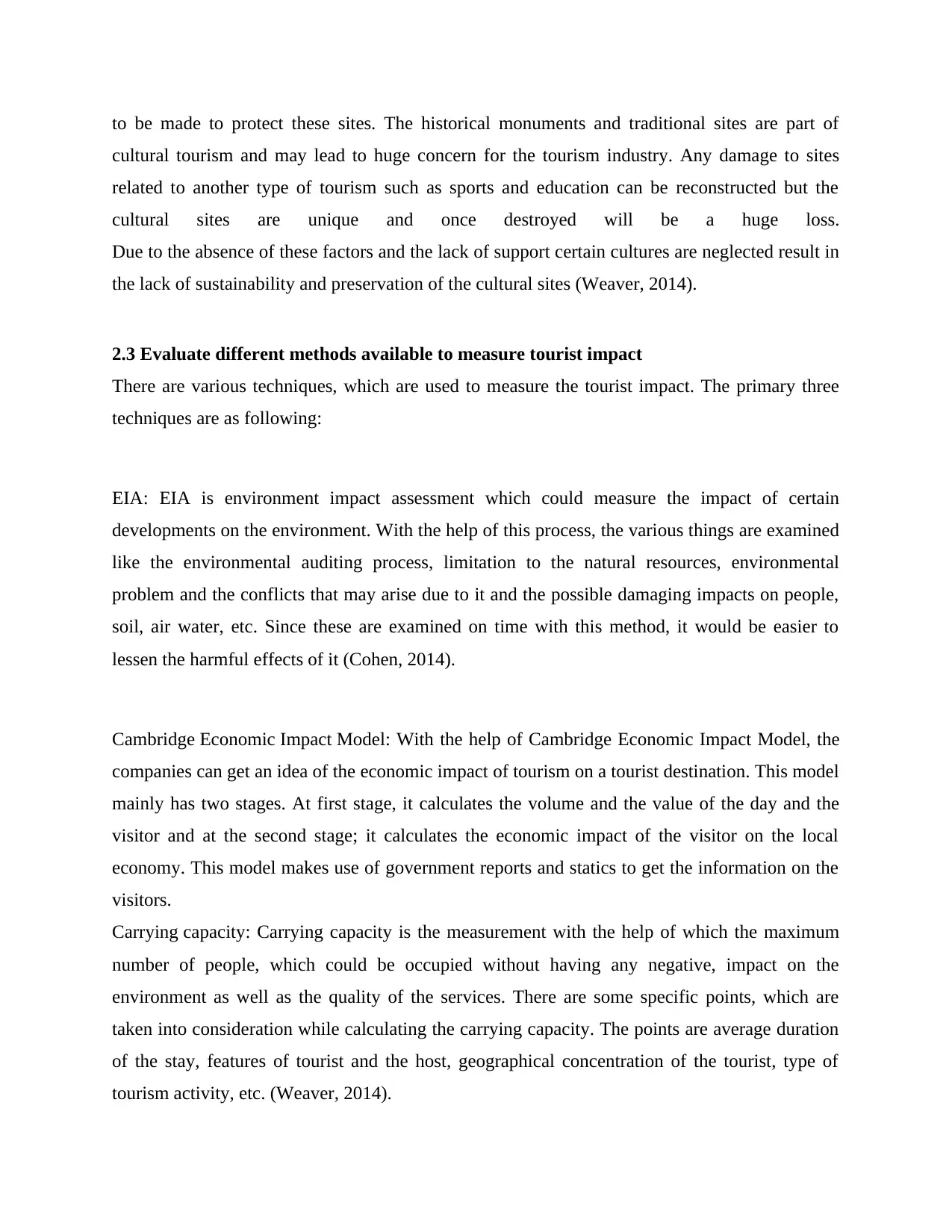
to be made to protect these sites. The historical monuments and traditional sites are part of
cultural tourism and may lead to huge concern for the tourism industry. Any damage to sites
related to another type of tourism such as sports and education can be reconstructed but the
cultural sites are unique and once destroyed will be a huge loss.
Due to the absence of these factors and the lack of support certain cultures are neglected result in
the lack of sustainability and preservation of the cultural sites (Weaver, 2014).
2.3 Evaluate different methods available to measure tourist impact
There are various techniques, which are used to measure the tourist impact. The primary three
techniques are as following:
EIA: EIA is environment impact assessment which could measure the impact of certain
developments on the environment. With the help of this process, the various things are examined
like the environmental auditing process, limitation to the natural resources, environmental
problem and the conflicts that may arise due to it and the possible damaging impacts on people,
soil, air water, etc. Since these are examined on time with this method, it would be easier to
lessen the harmful effects of it (Cohen, 2014).
Cambridge Economic Impact Model: With the help of Cambridge Economic Impact Model, the
companies can get an idea of the economic impact of tourism on a tourist destination. This model
mainly has two stages. At first stage, it calculates the volume and the value of the day and the
visitor and at the second stage; it calculates the economic impact of the visitor on the local
economy. This model makes use of government reports and statics to get the information on the
visitors.
Carrying capacity: Carrying capacity is the measurement with the help of which the maximum
number of people, which could be occupied without having any negative, impact on the
environment as well as the quality of the services. There are some specific points, which are
taken into consideration while calculating the carrying capacity. The points are average duration
of the stay, features of tourist and the host, geographical concentration of the tourist, type of
tourism activity, etc. (Weaver, 2014).
cultural tourism and may lead to huge concern for the tourism industry. Any damage to sites
related to another type of tourism such as sports and education can be reconstructed but the
cultural sites are unique and once destroyed will be a huge loss.
Due to the absence of these factors and the lack of support certain cultures are neglected result in
the lack of sustainability and preservation of the cultural sites (Weaver, 2014).
2.3 Evaluate different methods available to measure tourist impact
There are various techniques, which are used to measure the tourist impact. The primary three
techniques are as following:
EIA: EIA is environment impact assessment which could measure the impact of certain
developments on the environment. With the help of this process, the various things are examined
like the environmental auditing process, limitation to the natural resources, environmental
problem and the conflicts that may arise due to it and the possible damaging impacts on people,
soil, air water, etc. Since these are examined on time with this method, it would be easier to
lessen the harmful effects of it (Cohen, 2014).
Cambridge Economic Impact Model: With the help of Cambridge Economic Impact Model, the
companies can get an idea of the economic impact of tourism on a tourist destination. This model
mainly has two stages. At first stage, it calculates the volume and the value of the day and the
visitor and at the second stage; it calculates the economic impact of the visitor on the local
economy. This model makes use of government reports and statics to get the information on the
visitors.
Carrying capacity: Carrying capacity is the measurement with the help of which the maximum
number of people, which could be occupied without having any negative, impact on the
environment as well as the quality of the services. There are some specific points, which are
taken into consideration while calculating the carrying capacity. The points are average duration
of the stay, features of tourist and the host, geographical concentration of the tourist, type of
tourism activity, etc. (Weaver, 2014).
⊘ This is a preview!⊘
Do you want full access?
Subscribe today to unlock all pages.

Trusted by 1+ million students worldwide

Therefore, these are some of the methods with the help of which the impact of the tourists on any
destination could be measured.
destination could be measured.
Paraphrase This Document
Need a fresh take? Get an instant paraphrase of this document with our AI Paraphraser
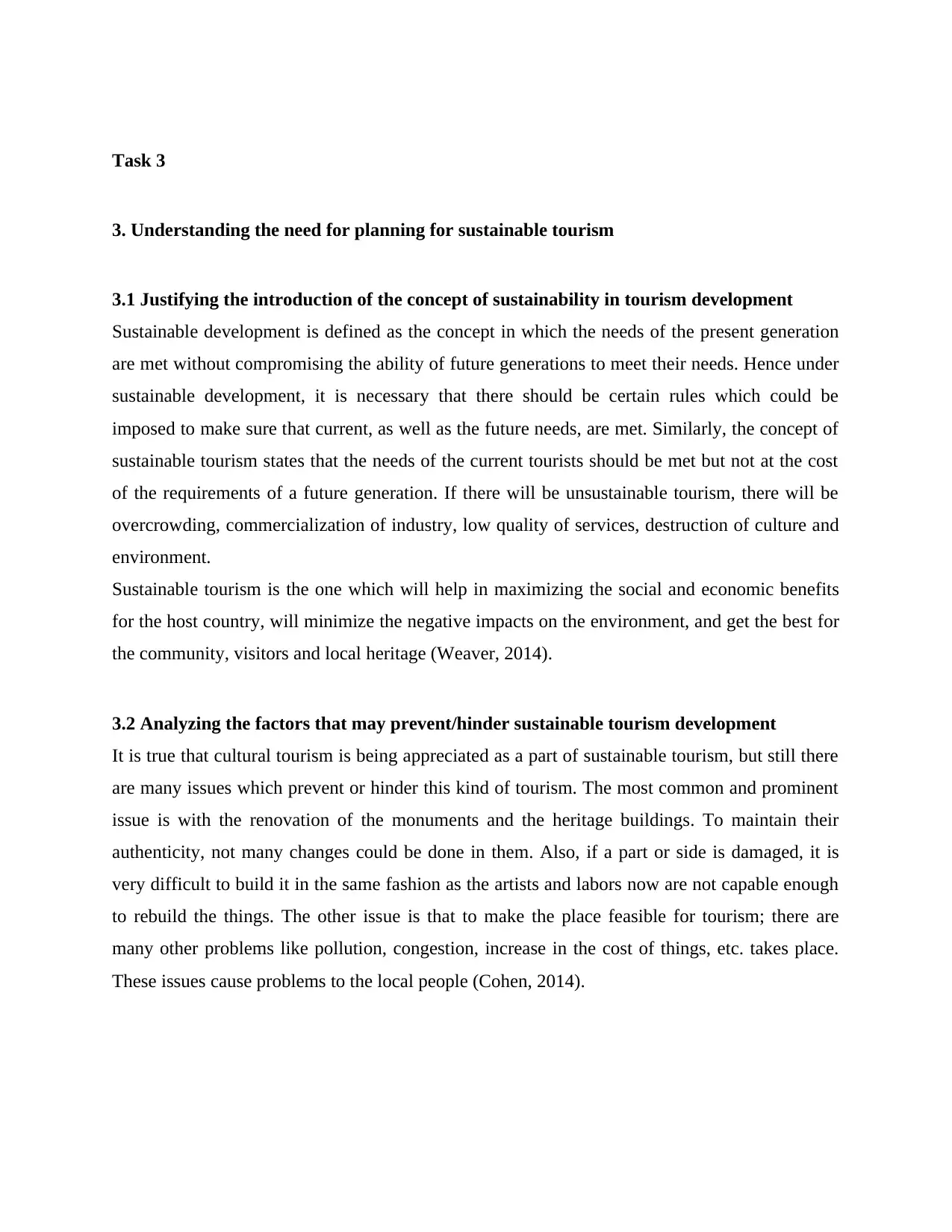
Task 3
3. Understanding the need for planning for sustainable tourism
3.1 Justifying the introduction of the concept of sustainability in tourism development
Sustainable development is defined as the concept in which the needs of the present generation
are met without compromising the ability of future generations to meet their needs. Hence under
sustainable development, it is necessary that there should be certain rules which could be
imposed to make sure that current, as well as the future needs, are met. Similarly, the concept of
sustainable tourism states that the needs of the current tourists should be met but not at the cost
of the requirements of a future generation. If there will be unsustainable tourism, there will be
overcrowding, commercialization of industry, low quality of services, destruction of culture and
environment.
Sustainable tourism is the one which will help in maximizing the social and economic benefits
for the host country, will minimize the negative impacts on the environment, and get the best for
the community, visitors and local heritage (Weaver, 2014).
3.2 Analyzing the factors that may prevent/hinder sustainable tourism development
It is true that cultural tourism is being appreciated as a part of sustainable tourism, but still there
are many issues which prevent or hinder this kind of tourism. The most common and prominent
issue is with the renovation of the monuments and the heritage buildings. To maintain their
authenticity, not many changes could be done in them. Also, if a part or side is damaged, it is
very difficult to build it in the same fashion as the artists and labors now are not capable enough
to rebuild the things. The other issue is that to make the place feasible for tourism; there are
many other problems like pollution, congestion, increase in the cost of things, etc. takes place.
These issues cause problems to the local people (Cohen, 2014).
3. Understanding the need for planning for sustainable tourism
3.1 Justifying the introduction of the concept of sustainability in tourism development
Sustainable development is defined as the concept in which the needs of the present generation
are met without compromising the ability of future generations to meet their needs. Hence under
sustainable development, it is necessary that there should be certain rules which could be
imposed to make sure that current, as well as the future needs, are met. Similarly, the concept of
sustainable tourism states that the needs of the current tourists should be met but not at the cost
of the requirements of a future generation. If there will be unsustainable tourism, there will be
overcrowding, commercialization of industry, low quality of services, destruction of culture and
environment.
Sustainable tourism is the one which will help in maximizing the social and economic benefits
for the host country, will minimize the negative impacts on the environment, and get the best for
the community, visitors and local heritage (Weaver, 2014).
3.2 Analyzing the factors that may prevent/hinder sustainable tourism development
It is true that cultural tourism is being appreciated as a part of sustainable tourism, but still there
are many issues which prevent or hinder this kind of tourism. The most common and prominent
issue is with the renovation of the monuments and the heritage buildings. To maintain their
authenticity, not many changes could be done in them. Also, if a part or side is damaged, it is
very difficult to build it in the same fashion as the artists and labors now are not capable enough
to rebuild the things. The other issue is that to make the place feasible for tourism; there are
many other problems like pollution, congestion, increase in the cost of things, etc. takes place.
These issues cause problems to the local people (Cohen, 2014).
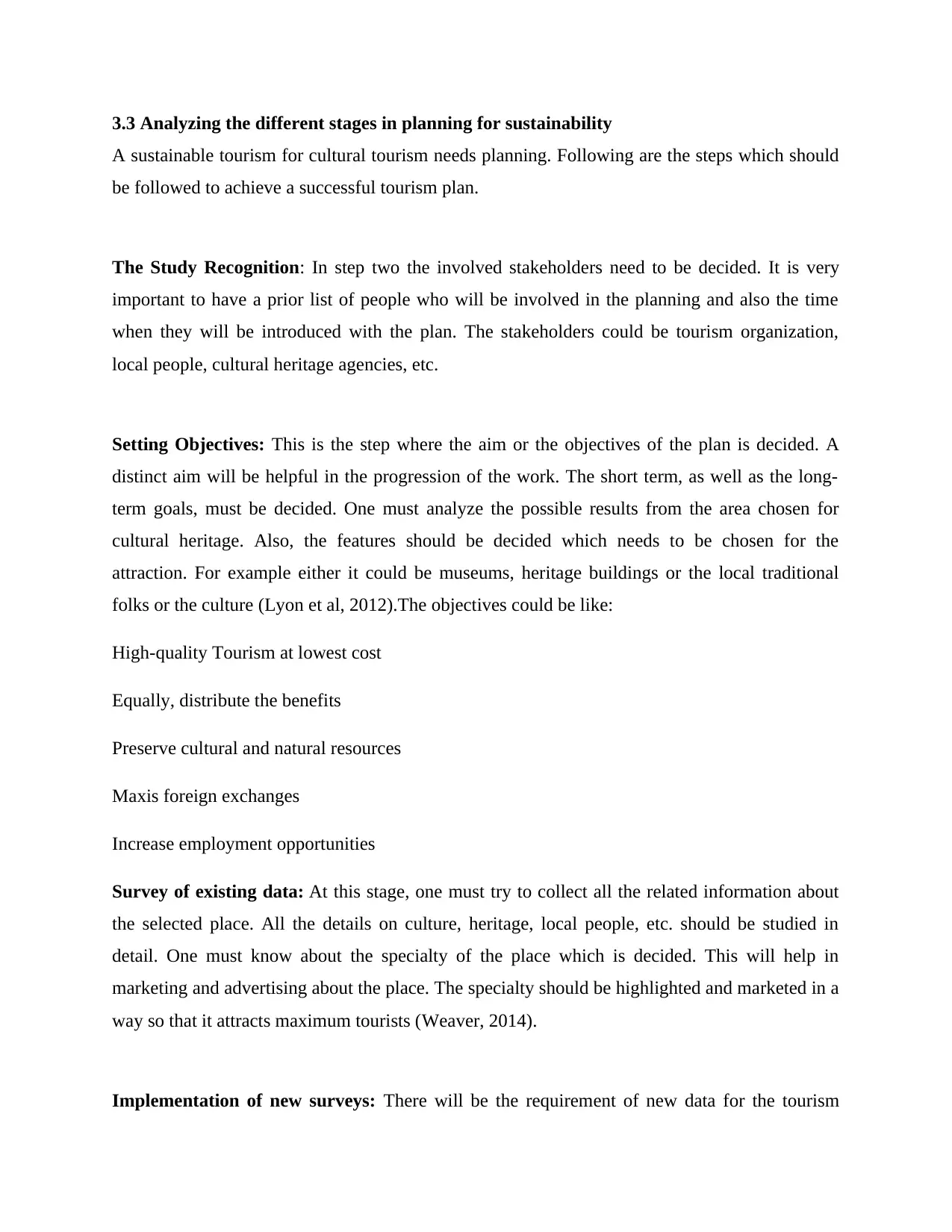
3.3 Analyzing the different stages in planning for sustainability
A sustainable tourism for cultural tourism needs planning. Following are the steps which should
be followed to achieve a successful tourism plan.
The Study Recognition: In step two the involved stakeholders need to be decided. It is very
important to have a prior list of people who will be involved in the planning and also the time
when they will be introduced with the plan. The stakeholders could be tourism organization,
local people, cultural heritage agencies, etc.
Setting Objectives: This is the step where the aim or the objectives of the plan is decided. A
distinct aim will be helpful in the progression of the work. The short term, as well as the long-
term goals, must be decided. One must analyze the possible results from the area chosen for
cultural heritage. Also, the features should be decided which needs to be chosen for the
attraction. For example either it could be museums, heritage buildings or the local traditional
folks or the culture (Lyon et al, 2012).The objectives could be like:
High-quality Tourism at lowest cost
Equally, distribute the benefits
Preserve cultural and natural resources
Maxis foreign exchanges
Increase employment opportunities
Survey of existing data: At this stage, one must try to collect all the related information about
the selected place. All the details on culture, heritage, local people, etc. should be studied in
detail. One must know about the specialty of the place which is decided. This will help in
marketing and advertising about the place. The specialty should be highlighted and marketed in a
way so that it attracts maximum tourists (Weaver, 2014).
Implementation of new surveys: There will be the requirement of new data for the tourism
A sustainable tourism for cultural tourism needs planning. Following are the steps which should
be followed to achieve a successful tourism plan.
The Study Recognition: In step two the involved stakeholders need to be decided. It is very
important to have a prior list of people who will be involved in the planning and also the time
when they will be introduced with the plan. The stakeholders could be tourism organization,
local people, cultural heritage agencies, etc.
Setting Objectives: This is the step where the aim or the objectives of the plan is decided. A
distinct aim will be helpful in the progression of the work. The short term, as well as the long-
term goals, must be decided. One must analyze the possible results from the area chosen for
cultural heritage. Also, the features should be decided which needs to be chosen for the
attraction. For example either it could be museums, heritage buildings or the local traditional
folks or the culture (Lyon et al, 2012).The objectives could be like:
High-quality Tourism at lowest cost
Equally, distribute the benefits
Preserve cultural and natural resources
Maxis foreign exchanges
Increase employment opportunities
Survey of existing data: At this stage, one must try to collect all the related information about
the selected place. All the details on culture, heritage, local people, etc. should be studied in
detail. One must know about the specialty of the place which is decided. This will help in
marketing and advertising about the place. The specialty should be highlighted and marketed in a
way so that it attracts maximum tourists (Weaver, 2014).
Implementation of new surveys: There will be the requirement of new data for the tourism
⊘ This is a preview!⊘
Do you want full access?
Subscribe today to unlock all pages.

Trusted by 1+ million students worldwide
1 out of 20
Related Documents
Your All-in-One AI-Powered Toolkit for Academic Success.
+13062052269
info@desklib.com
Available 24*7 on WhatsApp / Email
![[object Object]](/_next/static/media/star-bottom.7253800d.svg)
Unlock your academic potential
Copyright © 2020–2025 A2Z Services. All Rights Reserved. Developed and managed by ZUCOL.





